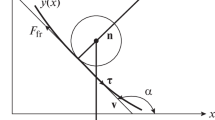Abstract
A two-parameter family of optimal curves in the brachistochrone problem in the case of Coulomb friction is found. The problem is represented in the form of the standard time minimization control problem. The normal component of the support reaction is used as control. It turned out that the formula for the optimal control, which does not include adjoint variables, has a singularity at the zero motion velocity. A system of ordinary differential equations is derived for which the solution of the Cauchy initial value problem makes it possible to obtain optimal trajectories that have a vertical tangent at the initial point. The self-similarity property of such trajectories is proved. It is shown how this property can be used to obtain by scaling all optimal trajectories from the set of optimal trajectories with fixed initial conditions and different terminal slope angles of the tangent.
Similar content being viewed by others
References
N. Ashby, W. E. Brittin, W. F. Love, and W. Wyss, “Brachistochrone with Coulomb friction,” Am. J. Phys. 43, 902–905 (1975).
S. C. Lipp, “Brachistochrone with Coulomb friction,” SIAM J. Control Optim. 35 (2), 562–584 (1997).
J. C. Hayen, “Brachistochrone with Coulomb friction,” Int. J. Non-Lin. Mech. 40, 1057–1075 (2005).
V. Covic and M. Veskovic, “Brachistochrone on a surface with Coulomb friction,” Int. J. Non-Lin. Mech. 43 (5), 437–450 (2008).
M. Ch. Wensrich, “Evolutionary solutions to the brachistochrone problem with Coulomb friction,” Mech. Res. Commun. 31 (2), 151–159 (2004).
A. S. Vondrukhov and Yu. F. Golubev, “Brachistochrone with an accelerating force,” J. Comput. Syst. Sci. Int. 53, 824 (2014).
A. S. Vondrukhov and Yu. F. Golubev, “Optimal trajectories in the brachistochrone problem with an accelerating force,” J. Comput. Syst. Sci. Int. 54, 514 (2015).
Yu. F. Golubev, “Brachistochrone with friction,” J. Comput. Syst. Sci. Int. 49, 719 (2010).
Author information
Authors and Affiliations
Corresponding author
Additional information
Original Russian Text © A.S. Vondrukhov, Yu.F. Golubev, 2016, published in Izvestiya Akademii Nauk. Teoriya i Sistemy Upravleniya, 2016, No. 3, pp. 11–18.
Rights and permissions
About this article
Cite this article
Vondrukhov, A.S., Golubev, Y.F. Optimal trajectories in brachistochrone problem with Coulomb friction. J. Comput. Syst. Sci. Int. 55, 341–348 (2016). https://doi.org/10.1134/S1064230716030163
Received:
Accepted:
Published:
Issue Date:
DOI: https://doi.org/10.1134/S1064230716030163



